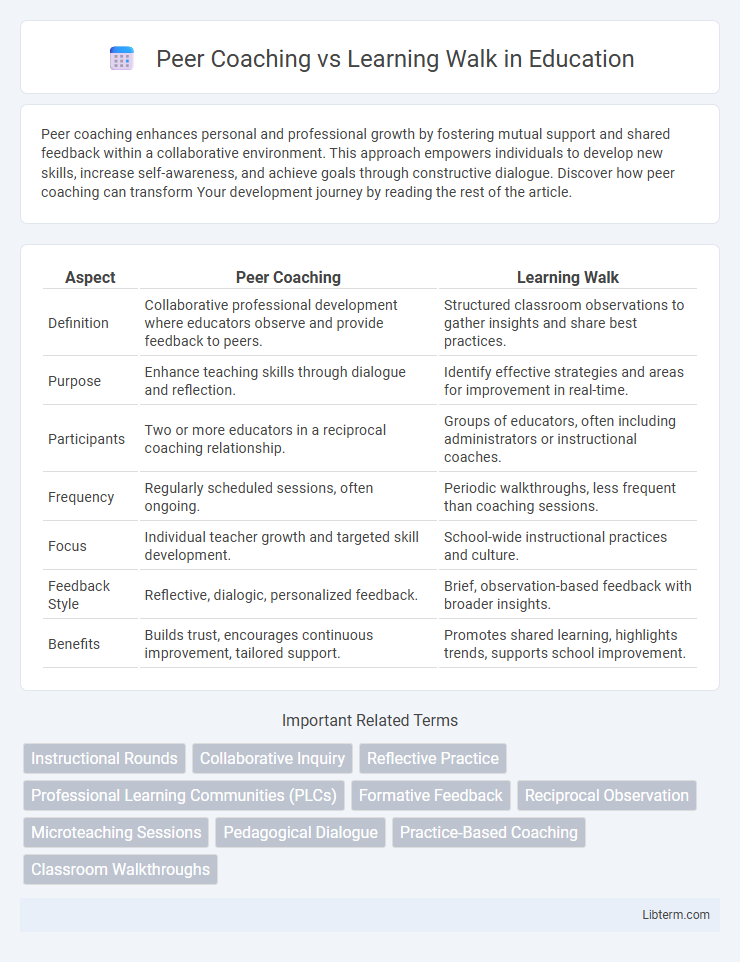Peer coaching enhances personal and professional growth by fostering mutual support and shared feedback within a collaborative environment. This approach empowers individuals to develop new skills, increase self-awareness, and achieve goals through constructive dialogue. Discover how peer coaching can transform Your development journey by reading the rest of the article.
Table of Comparison
| Aspect | Peer Coaching | Learning Walk |
|---|---|---|
| Definition | Collaborative professional development where educators observe and provide feedback to peers. | Structured classroom observations to gather insights and share best practices. |
| Purpose | Enhance teaching skills through dialogue and reflection. | Identify effective strategies and areas for improvement in real-time. |
| Participants | Two or more educators in a reciprocal coaching relationship. | Groups of educators, often including administrators or instructional coaches. |
| Frequency | Regularly scheduled sessions, often ongoing. | Periodic walkthroughs, less frequent than coaching sessions. |
| Focus | Individual teacher growth and targeted skill development. | School-wide instructional practices and culture. |
| Feedback Style | Reflective, dialogic, personalized feedback. | Brief, observation-based feedback with broader insights. |
| Benefits | Builds trust, encourages continuous improvement, tailored support. | Promotes shared learning, highlights trends, supports school improvement. |
Introduction to Peer Coaching and Learning Walk
Peer coaching involves a collaborative relationship where educators observe each other's teaching practices to provide constructive feedback aimed at professional growth. Learning walks consist of brief, informal classroom visits by peers or leaders to gather insights on instructional strategies and student engagement without formal evaluation. Both methods promote reflective practice and continuous improvement but differ in structure and depth of interaction.
Definitions: Peer Coaching vs Learning Walk
Peer Coaching involves a collaborative process where two or more educators observe, reflect, and provide feedback to enhance instructional practices and professional growth. A Learning Walk is a structured, often team-based observation method in which educators visit multiple classrooms to gather evidence on teaching strategies and student engagement practices. Both approaches aim to improve teaching effectiveness but differ in scope, with Peer Coaching emphasizing personalized mentorship and Learning Walks focusing on broader instructional trends.
Core Objectives of Peer Coaching
Peer Coaching centers on collaborative skill development through reflective dialogue and targeted feedback, aiming to improve teaching practices and student outcomes. It prioritizes mutual support among educators to identify strengths and address challenges in real-time classroom settings. Unlike Learning Walks, which focus on observational data collection and school-wide instructional trends, Peer Coaching emphasizes ongoing professional growth through personalized, interactive mentorship.
Core Objectives of Learning Walk
Learning Walks primarily aim to observe classroom interactions and instructional methods, fostering reflective dialogue among educators to enhance teaching practices. This approach emphasizes real-time feedback and collaborative problem-solving to boost student engagement and learning outcomes. In contrast, Peer Coaching centers on sustained one-on-one mentoring to develop personalized professional growth and targeted skill improvement.
Methodology: How Peer Coaching Works
Peer coaching employs a collaborative methodology where two or more educators engage in structured dialogues to reflect on teaching practices, set goals, and provide constructive feedback. This process typically involves pre-observation planning, classroom observation, and post-observation discussions centered on specific teaching strategies and learner outcomes. Emphasizing reciprocal learning, peer coaching fosters continuous professional development through mutual support and evidence-based reflection.
Methodology: How Learning Walks are Conducted
Learning Walks are conducted through structured, observational visits where educators systematically observe teaching practices and student engagement without interrupting. This methodology involves predefined focus areas aligned with school improvement goals, and observers take detailed notes to provide evidence-based feedback. Unlike Peer Coaching, which emphasizes reciprocal dialogue and reflection, Learning Walks prioritize data collection and objective analysis to inform instructional strategies.
Key Differences Between Peer Coaching and Learning Walk
Peer coaching involves reciprocal, collaborative sessions where colleagues observe each other's teaching practices and provide constructive feedback to enhance professional growth. Learning walks consist of short, non-evaluative visits by leaders or peers to classrooms primarily aimed at gathering insights on teaching methods and student engagement. The key difference lies in peer coaching fostering ongoing dialogue and personalized development, whereas learning walks focus on observational data collection and broader instructional trends.
Advantages of Peer Coaching
Peer coaching enhances personalized professional growth by enabling educators to exchange targeted feedback, fostering reflective practices that directly improve teaching strategies. It cultivates a collaborative culture, promoting trust and continuous dialogue among peers which leads to sustained skill development and innovation. This method surpasses learning walks by providing ongoing support, adaptability to individual needs, and a deeper understanding of classroom dynamics.
Benefits of Learning Walk
Learning Walks enhance professional development by providing real-time observational feedback, fostering collaborative reflection among educators, and identifying best practices in diverse classroom settings. These structured visits promote a culture of continuous improvement and shared expertise, leading to improved teaching strategies and student outcomes. Unlike peer coaching, Learning Walks offer a broader perspective by engaging multiple staff members and focusing on collective learning environments rather than individual teacher support.
Choosing the Right Approach for Professional Development
Peer coaching emphasizes collaborative skill-building through personalized feedback and reflection, making it ideal for sustained professional growth. Learning walks provide observational insights by examining real-time teaching practices across classrooms, supporting immediate instructional improvements. Selecting the right approach depends on goals: peer coaching suits deep, continuous development, while learning walks are effective for quick, contextual feedback and sharing best practices.
Peer Coaching Infographic

 libterm.com
libterm.com